This is part two of the ABSD article series, which analyses the impact of ABSD adjustments on foreigners – the first part is here.
Disclaimer: This article will examine skilled foreigners who are not classified as High Net-Worth Individuals (HNWIs) and are not covered by the benefits of the free trade agreements (FTAs) established with Singapore.
Attracting skilled foreign professionals has long been a strategic policy adopted by the Singapore government in response to demographic challenges, including a rapidly ageing population and low birth rates. However, with the current high ABSD environment for foreigners, this raises questions about whether the increased foreigner ABSD discourages foreigners from coming to Singapore to settle and contribute to the economy.
Demographic challenges faced in Singapore
Singapore has been experiencing a decline in birth rates. As of 2024, Singapore’s resident total fertility rate remains at a historic low of 0.97 births per woman since 2023, with an average decline rate of approximately 4.28% year on year. Even the culturally significant “Dragon Year” in 2024, which is traditionally associated with birth spikes, failed to boost Singapore’s fertility, reflecting shifting priorities and goals among young couples.
Chart 1: Birth rate in Singapore (2015-2024)

Source: singstat.gov.sg
As highlighted in the Population White Paper 2013, Singapore’s total population is expected to reach between 6.5 and 6.9 million by 2030. However, growth rates for Singaporeans and Permanent Residents have been sluggish, with a compound annual growth rate (CAGR) of +0.7%. This contrasts with a higher growth rate for non-residents, at a CAGR of +1.5%.
The current population of Singapore is 6 million, with a total of 30,808 resident live births as of 2024. Assuming the birth rate remains constant, it will be very difficult to reach the target of 6.5 million by 2030 without either significantly increasing the local birth rate or attracting more foreign nationals. This shows that foreigners continue to play a vital role in supporting the overall population and helping to achieve a higher population goal.
As such, we observed the Singapore government implementing a two-pronged approach: encouraging locals to have children through incentives like the Baby Bonus Scheme, and attracting foreigners to Singapore to establish businesses, such as the Overseas Networks & Expertise Pass (ONE Pass) introduced in Jan 2023.
Chart 2: Population growth of Singapore (2013- 2024)

Source: singstat.gov.sg
Attracting foreign skilled workers to migrate to Singapore, settle, and contribute to the economy has therefore been a key message echoed by the Singapore government, compelling Singapore to remain open to global talent to sustain its economic resilience and international standing.
How does ABSD impact decision-making for foreigners who want to purchase property in Singapore
While the high ABSD rates do prevent speculative demand, they also impact foreigners who plan to purchase private property for long-term residence. The 60% ABSD rate on a first property for foreigners results in a significant cost difference compared to SPRs, who only pay 5%. Consequently, there is a financial disincentive for foreigners to establish their roots here through property ownership.
Table 1: Calculation of ABSD when purchasing first property

Source: ERA Research & Market Intelligence
Therefore, the most practical way for foreigners to buy property for personal residence is to initially rent then apply for PR status to minimise the ABSD tax burden. However, this approach may not be sustainable in the long term.
Looking at the Rental Price Index (RPI), rents have surged since the end of COVID, likely due to the reopening of borders and an influx of new foreigners. The sustained high level indicates strong rental demand, with the index remaining consistently above 160 for OCR and RCR segments since its peak in 1H 2023.
Chart 3: Rental Price Index Across Market Segments (1Q 2020 – 1Q 2025)
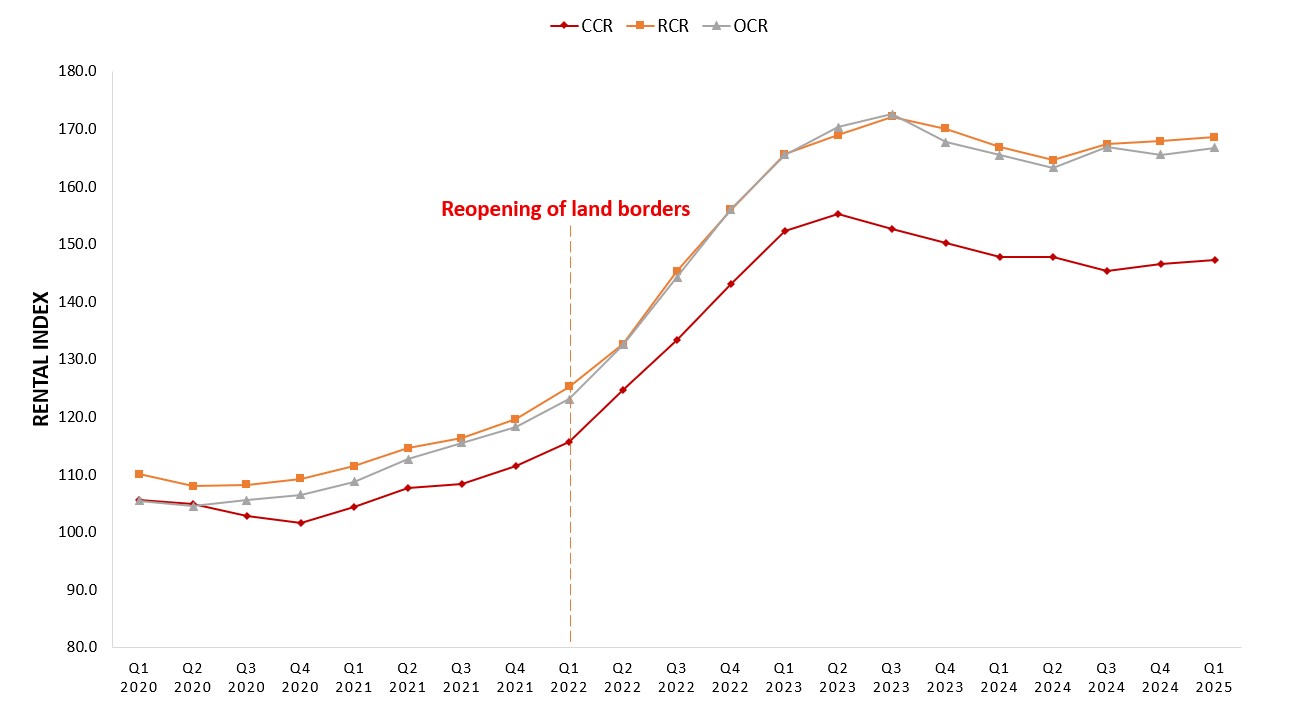
Source: URA REALIS, ERA Research & Market Intelligence
Moreover, rents are increasingly taking up a significant portion of monthly income, especially for foreigners holding Employment Passes and S-Passes. Based on average monthly rental data for a typical 2-bedroom private unit, foreigners on S-Passes will face rental costs that exceed their current qualifying salary of $3,150. For foreigners on an Employment Pass, the average rent for CCR units accounts for approximately 90% of their minimum monthly qualifying wage of $5,500, whereas renting units in the RCR and OCR will take up approximately 56% to 70% of their monthly income.
Such figures thus highlight the financial strain faced by middle-tier foreign professionals in securing affordable rents while waiting for their PR approvals.
Chart 4: 5-Year Average Monthly Rent For a 2-Bedroom Private Non-Landed Property (2020-2025)

Source: URA REALIS, ERA Research & Market Intelligence
HDB rental rates to remain strong
Alternatives such as renting HDB flats, while an affordable option for foreigners, are likely to see more rental price increases as the number of MOP flats continues to tighten at an average rate of 18,2% decline per year, decreasing the number of flats entering the rental market. Considering possible competition from local renters and price-sensitive tenants amidst the current economic uncertainty, demand for HDB rentals might rise and persist, applying more upward pressure on rental prices. However, not all flats reaching their Minimum Occupation Period translate into rental stock; a significant proportion remains owner-occupied, which caps the HDB rental supply.
Chart 5: Number of HDB flats reaching the 5-Year MOP period
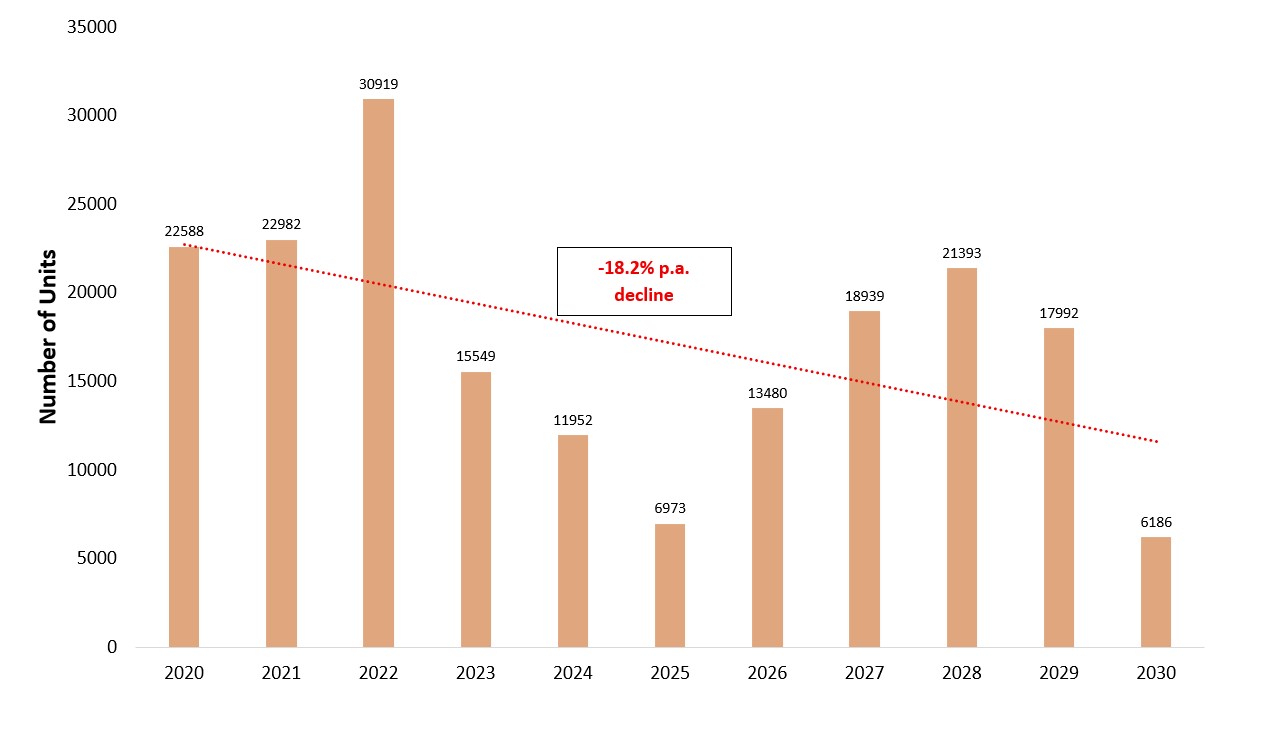
Source: data.gov.sg, ERA Research & Market Intelligence
Amidst supply-side constraints, foreigners who opt for the rent-and-wait approach will face higher costs and might not prove to be a suitable long-term solution for owning a property in Singapore. This adds to the already lengthy and stringent process of obtaining a SPR, which involves multiple criteria and considerable uncertainty.
Is it time to rethink ABSD for Foreigners Who Intend to Stay Long Term
To better align housing policy with Singapore’s broader population and foreign talent objectives, adjustments can be considered to the current ABSD policy for foreigners while maintaining its deterrent effect on speculative demand.
One potential policy recommendation is a tiered ABSD remission scheme for foreigners who demonstrate genuine intent to reside long-term, rather than purchase for investment purposes. Conditions such as obtaining PR status and meeting minimum occupancy targets can be considered to further encourage foreigners for long-term stay.
Table 2: Example of a tiered ABSD Remission Scheme (up to 30%)

Conclusion
As Singapore navigates demographic shifts and global competition for foreign talent, its housing policy must also adapt accordingly. Looking beyond the use of ABSD as a deterrent, a targeted and effective ABSD policy for foreigners could remove key obstacles in Singapore’s population strategy.
On that note, in part 3 of our article series, we will expand this discussion by examining the Core Central Region (CCR). This market is the most vulnerable to foreign buyer trends and is therefore crucial to analyse what is needed to sustain long-term market resilience despite the high ABSD environment.
Disclaimer
This information is provided solely on a goodwill basis and does not relieve parties of their responsibility to verify the information from the relevant sources and/or seek appropriate advice from relevant professionals such as valuers, financial advisers, bankers and lawyers. For avoidance of doubt, ERA Realty Network and its salesperson accepts no responsibility for the accuracy, reliability and/or completeness of the information provided. Copyright in this publication is owned by ERA and this publication may not be reproduced or transmitted in any form or by any means, in whole or in part, without prior written approval.
ERA: Built on Trust, Not Just Transactions
When confronted with illness, many individuals withdraw and take time for themselves. In contrast, Ahmad Ibrahim consistently makes an effort to be present for those in his life.

Ahmad Ibrahim pictured with his wife and Deputy CEO Doris Ong during Hari Raya celebration — a reflection of his commitment to community, family, and the people who journey with him.
Despite his seventh round of chemotherapy, carrying a blood-pumping machine, and coping with the effects of treatment, Ahmad remains dedicated to his clients. He stays reachable on his phone, attends viewings, and provides guidance to anyone who contacts him.
Whenever he misses a call, he apologizes—even if he’s in the hospital. His clients frequently urge him to prioritise his health, but Ahmad keeps working. He clings to a straightforward mantra: They need me. I’ll rest later.
“You’d think this is about being hardworking or chasing income,” he says. “But it’s not. It’s about being there when people need someone to care.”
That spirit came through powerfully in one of the most emotional cases he’s ever handled. A wheelchair-bound man in his 70s was facing eviction after a painful divorce. His children had turned away. With no money, no plan, and nowhere to go, he confided in Ahmad that he wanted to end his life.
Ahmad could have turned away, but he didn’t.
Ahmad not only listened and encouraged the man to seek assistance from his MP but also provided him with some money to help him through. Furthermore, he contacted the man’s estranged younger brother and persuaded him to provide temporary housing. On the day the sale was completed, Ahmad picked the man up and took him to his new accommodations, ensuring he wasn’t alone.
Ahmad serves with the same quiet resolve as he continues his current treatment course. Some clients call about simple matters, such as how to apply for a BTO flat. Although he doesn’t receive any monetary reward, Ahmad still takes the time to guide them through the application process step by step, even offering to speak directly to HDB officers on their behalf.
It’s clear that for Ahmad, serving his clients isn’t just about commitment—it’s about demonstrating compassion under pressure. This kind of service doesn’t stem from obligation but from something deeper: a desire to see others move forward.
In 2024, Ahmad earned recognition as one of ERA’s Top 3 First in Service among over 8,000 agents. On the same day, he was also honoured with the Top 50 ERA Achiever Award.

A proud milestone: Ahmad Ibrahim receiving his Rising Millionaire Award — a testament to his determination, resilience, and the trust he’s earned from clients through heartfelt service.
He has earned a 5.0-star client rating on ERA’s Property Portal, showcasing the steadfast trust his clients have in him and highlighting the significant impact his care brings to each transaction.
“This recognition means a lot to me—not just because of the title, but because it reflects the trust my clients place in me and the dedication I pour into every relationship,” he shared.
“In our line of work, service is everything. It’s about listening, caring, and always going the extra mile. And I’ll continue to strive for that every step of the way.”
His work ethic is highly appreciated by his clients, as evident in the numerous glowing reviews they have left for him:
“Ahmad Ibrahim is very knowledgeable in the property market… He has gone beyond and gone the extra mile in fulfilling my demands. He is the best property agent I’ve engaged.”
“Your expertise and professionalism made the entire process seamless and stress-free… We truly appreciate your commitment to helping my parents find their perfect home.”
“He is kind, and I highly recommend Mr Ahmad to my family or friends. It’s a pleasure working with him throughout this journey.”
In an agency that prioritises client experience, Ahmad’s story reflects one of many that bolster ERA’s impressive 99.8% professional excellence rating, as determined by customer feedback.
For Ahmad, real achievement goes beyond awards. It focuses on the importance of giving—especially in tough times and when it truly counts.
At ERA, we focus not only on closing deals but also on opening hearts. Ahmad’s journey exemplifies resilience, purpose, and unwavering dedication to service.
Co-written By Egan Mah & Stanley Lim
It’s the classic narrative of Singapore’s housing landscape: dating, getting married, and then moving into a newly completed Build-to-Order (BTO) flat as newlyweds. However, this familiar route isn’t always accessible to everyone, whether by personal choice or due to circumstances beyond their control.
Thankfully, for those who are unable to enjoy shared ownership of a property with a spouse, there are still avenues to enter Singapore’s property market with a trusted someone – be they a live-in partner, close friend, or family member. This guide will explore the various housing options, eligibility criteria, and key considerations for co-owning a Singapore property even when legal marriage isn’t on the cards.
Why is property co-ownership outside of marriage a consideration for some Singaporeans?
There are numerous reasons why some Singaporeans might opt to co-own a residential property outside of marriage.
While some aspiring homeowners may choose to do so due to practical concerns, such as financial constraints or caregiving responsibilities towards a disabled and/or elderly family member, others may be motivated by personal circumstances. Moreover, not all aspiring homeowners fall within the conventional definitions of family or marital status; yet they too are also seeking pathways to co-ownership.
For instance, a widower who has found love again may choose not to remarry to avoid the hurdles of legal marriage. Accordingly, they might choose to co-own a property with their new partner, which would enable them to build a shared home, sans the bureaucracy and formalities.
From a purely financial perspective, there is also a compelling case for co-ownership outside of marriage, given the robustness of Singapore’s property market. Property has long been regarded as a reliable investment asset locally, owing to its history of consistent appreciation. Between 2021 and 2025 alone, HDB flats and private homes have experienced significant upward momentum, as evidenced by the sharp 41.3% (142.2 to 200.9) and 30.1% (162.2 to 211.1) increases in their respective price indices.
Chart 1: HDB resale price index (RPI) and private residential property price index (PPI) from 1Q 2021 to 1Q 2025

Source: URA, HDB, ERA Research and Market Intelligence
In this light, property co-ownership transcends merely fulfilling housing needs; it also represents a strategic decision for long-term financial security. This is especially relevant for those who may not have children of their own and/or lack familial support in later stages of life.
However, given the increasing proportion of singles in Singapore’s resident population, personal choice and/or a desire for freedom are likely the main factors influencing interest in alternative paths to homeownership, including co-ownership arrangements.
Chart 2: Growth in single-person households as a proportion of total resident households (2000 – 2024)
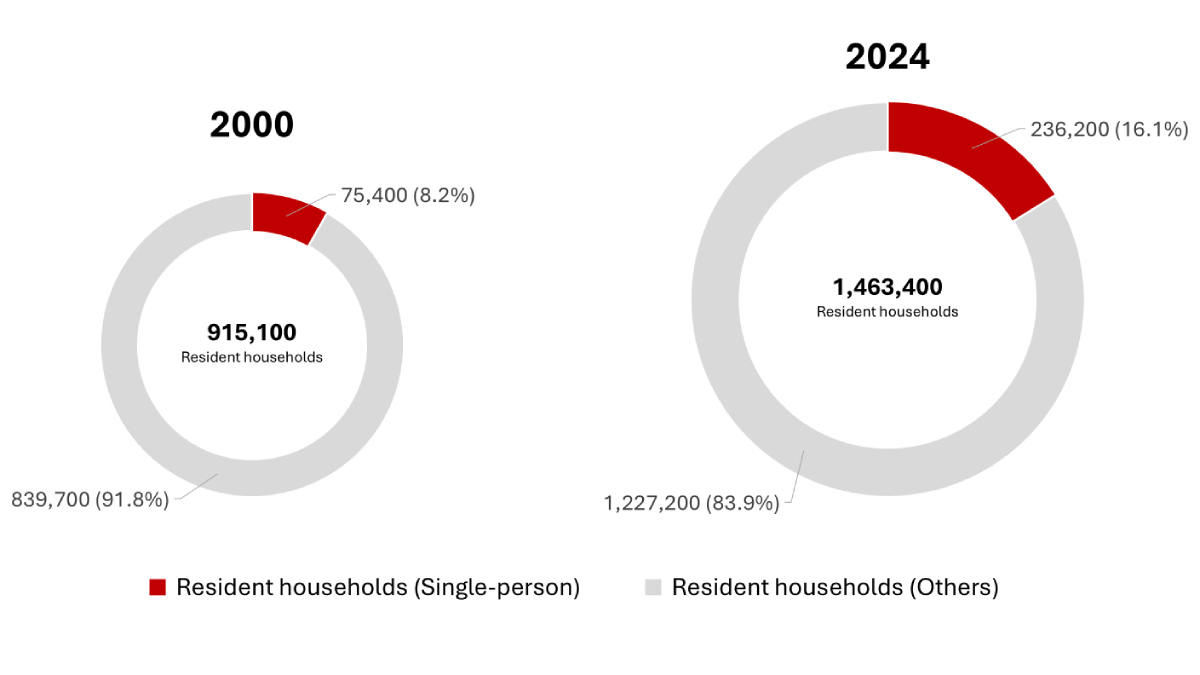
Source: SingStat, ERA Research and Market Intelligence
These beliefs tie in with a greater preference for single living as well, especially among Singaporeans seeking flexibility and privacy. Based on official SingStat figures, the number of single-person resident households has risen by over 200% from 75,400 in 2020 to 236,200 in 2024. Likewise, the share of single-person resident households has also seen a notable increase, doubling from 8.2% in 2000 (75,400 of 915,100 households) to 16.1% in 2024 (236,200 of 1,463,400 households).
Therefore, given the increasing prevalence of singlehood among Singaporeans, it is reasonable to suggest that there may indeed be a growing need to reimagine local homeownership beyond the traditional couple-centric model.
The Singapore Government has taken steps in this direction, with the most recent change being the expansion of public housing options for singles. A key policy revision in the second half of 2024 now allows singles – or, for co-ownership purposes, groups of up to four singles – to purchase 2-room Flexi HDB flats in any housing estate, including prime locations.
However, different homeownership requirements and considerations will apply depending on whether one is considering co-owning an HDB flat, an executive condominium (EC), or private housing.

What are the laws, rules and considerations for co-owning different residential properties for joint-singles?
Buying an HDB flat will require all parties to be at least 35 years old.
While HDB offers numerous eligibility schemes to support various demographic groups in their housing journey, single buyers interested in co-owning a flat need only focus on one: the Joint Singles Scheme.
Introduced in 1990, the Joint Singles Scheme allows eligible Singaporean men and women at least 35 years old to jointly purchase an HDB flat or Executive Condominium (EC). However, those who are widowed or orphaned may qualify from the age of 21, but only for resale Prime flats, unclassified resale flats, and new Standard and Plus flats.
For the purposes of this piece, we consider joint single households to be living arrangements involving two to four unmarried individuals of any gender. Additionally, if you intend to apply under the Joint Singles Scheme, it is important to take note of the following requirements:
Table 1: Joint singles eligibility criteria for HDB and EC flat purchases

Source: HDB, ERA Research and Market Intelligence
*Unclassified resale flats refer to HDB homes sold before the October 2024 sales exercise that do not fall under either Standard, Plus, or Prime classification categories.
Private home ownership is less cumbersome.
Unlike HDB flats or Executive Condominiums, purchasing private property as co-owners is not subject to specific eligibility criteria. However, co-buyers must consider the manner of holding or, more simply, how ownership is legally shared. This is particularly important for inheritance, as the selected holding method determines how the property is passed on after a co-owner’s death.

What are the different manners of holding or ownership types, and how do they matter in inheritance planning?
So, there are two property ownership types in Singapore, namely holding the property in Joint Tenancy and Tenancy-in-common. For HDBs, applicants under the Joint Singles Scheme must be registered as co-owners (i.e. the owner-occupier structure is not allowed).
While joint tenancy is the default holding method for HDB flats, buyers can opt for tenancy-in-common. However, this may come with higher legal fees due to the higher complexity of arrangements and the potential for disagreements.
- Joint Tenancy
Under a joint tenancy structure, there is an undivided interest in the property. All owners are regarded as owning the entire property collectively, with no separate or distinct shares. When one owner passes away, the rights of survivorship come into effect. This means that the surviving owner automatically inherits the rights to the full share of the property, irrespective of any existing will.
This is with the exception of when both parties pass away at the same time. In such cases, the order of death becomes legally significant. However, when it is impossible to determine (e.g., simultaneous death in an accident), Singapore law presumes that the younger person passes away later. Hence, the younger party will inherit the entire property before passing it on to their next of kin or will beneficiaries.
For example, Jamie and Ashley are both unmarried 35-year-old singles with no family, who decide to buy an HDB flat together under a joint tenancy arrangement. If Jamie passes away, Ashley will inherit full ownership of the flat.
Below, we have summarised the characteristics of both manners of holding:
Table 2: Summary of manner of holding of property

Source: ERA Research and Market Intelligence
- Tenancy-in-Common
Under the tenancy-in-common structure, owners can agree on their respective ownership percentages, provided they total 100%. For instance, if one party pays for 70% of the property and the other covers 30%, they hold a 70-30% share. These shares are detailed in the title deed. Upon death, each owner’s share will pass to their respective estate rather than to the surviving owner.
If all owners pass away simultaneously, each owner’s share will be allocated to their respective beneficiaries under their wills or according to the Intestate Succession Act if no will exists. The assets will be divided in accordance with the act.
Table 3: Common beneficiaries under the Intestate Succession Act*

Source: Singapore Statutes online (sso.agc.gov.sg)
* The Intestate Succession Act does not apply to Muslims. The estate of a Muslim is governed by Muslim law. ** ‘Issue’ is a legal term referring to one’s direct descendants.
The Tenancy-in-Common ownership structure would be ideal for two parties who have their own estates to pass on the property to, such as divorcees or widows with children, coming together to jointly purchase a property.
For instance, Lewis and Jesse own 70% and 30% of a condominium unit, respectively. If Jesse were to pass away, his share (70%) would go to his estate according to his will, while Lewis would continue owning 30% of the property.

Beyond legalities, what else should you consider before co-owning a residential property?
For many, the legal, emotional, and financial advantages of co-owning a property outside of marriage are very real. Still, it is equally important to recognise the responsibilities and risks that come with it.
Firstly, just as in marriages, breakdowns in relationships between co-owners can make living together challenging. However, unlike most relationships, where it is possible to walk away from the other party, you will be tied to the shared property unless both parties reach a consensus on future ownership.
The same goes for scenarios where financial difficulty is a concern. If one party is unable to cover their share of costs (e.g., mortgage, maintenance fees), the financial pressure may unfairly fall on the rest.
Lastly, inheritance disputes could arise even if a manner of holding or inheritance has been specified. For instance, in an emotionally charged situation, family members of a deceased co-owner may still choose to contest a will despite its legal standing.
For these reasons and more, all parties involved should establish a shared understanding and make definitive arrangements on how ownership should be handled in good times and in bad, before proceeding with a purchase.
Beyond formalising the manner of holding, prudent buyers may also consider drafting a will to facilitate smooth and unambiguous future transfers, particularly when a joint tenancy is involved. Likewise, a consultation with legal and real estate professionals is recommended for more precise understanding and informed guidance. Because just as with the people you love, those you share a roof with deserve nothing less than care and clarity.
Disclaimer
This information is provided solely on a goodwill basis. It does not relieve parties of their responsibility to verify the information from the relevant sources and/or seek appropriate advice from relevant professionals such as valuers, financial advisers, bankers and lawyers. For the avoidance of doubt, ERA Realty Network and its salesperson accept no responsibility for the accuracy, reliability and/or completeness of the information provided. ERA owns the copyright in this publication, and this publication may not be reproduced or transmitted in any form or by any means, in whole or in part, without prior written approval.
The 2H 2025 Government Land Sales (GLS) program introduced 4,725 private residential units in the Confirmed List. This brings our total annual Confirmed List supply close to 10,000 units. A total of ten sites were placed on the Confirmed List, comprising five private residential sites, three Commercial and Residential sites, and two EC sites.
Collectively, the 2H 2025 GLS Confirmed List totals an estimated 4,725 private homes, which encompass 990 Executive Condominium (EC) units, while the Reserve List will yield an additional 2,460 residential units. Overall, the private home supply (on the Confirmed List) slated for 2H 2025 fell by 6.7% compared to 1H 2025.
“The continued release of private housing supply aims to moderate recent bullish land bids in selected locations that have seen overwhelming interest. The release of sites, such as Dunearn Road and Woodlands Drive 17 (EC) could ease competition for nearby sites and potentially moderate land bids.”
Chart 1: Residential GLS Sites (No. of Units)
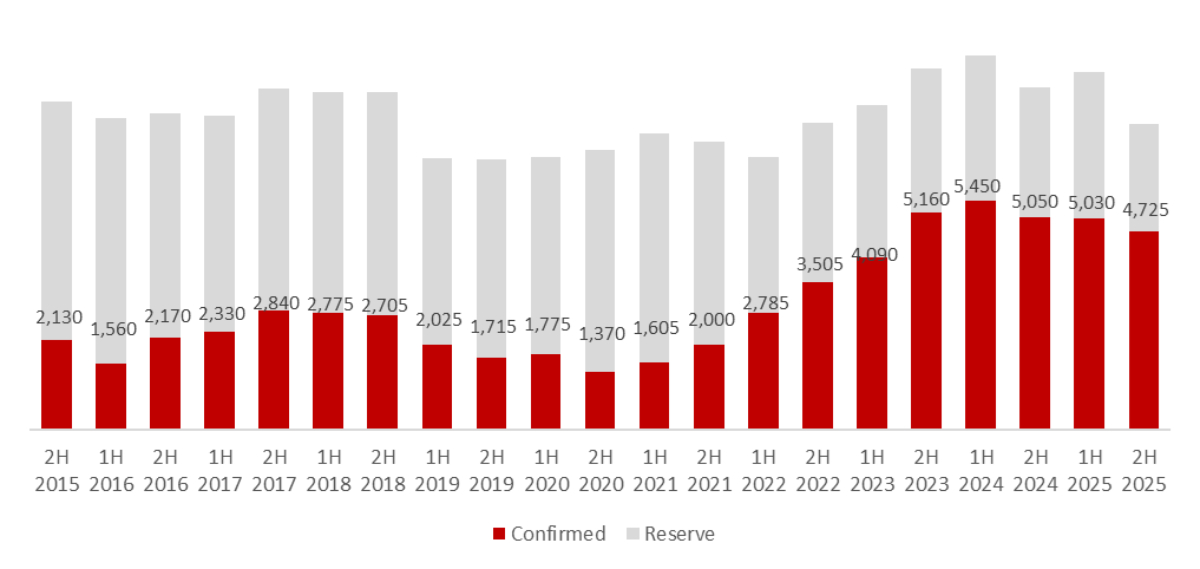
Source: URA, ERA Research and Market Intelligence
Where are the promising sites?
The Dunearn Road site will be the second private residential development launched following the announcement of Bukit Timah Turf City’s redevelopment plans earlier this year. The private residential site is nestled among the first upcoming HDB flats in Bukit Timah, and we expect the future residents to benefit from ample amenities as the area undergoes transformation. Demand for this site will be interesting to watched based off the performance of the prior Dunearn Road site that will close in late June.
The other CCR site in Newton at Bukit Timah Road will also draw in developer’s interest due to its strong location adjacent to Newton MRT interchange. The location will draw in both owner occupiers and investment buyers, due to its unique central location located not only near offices and the CBD, but also family friendly amenities and a good nearby primary school in ACS Junior.
Among the sites unveiled in the 2H 2025 GLS slate, Dover Road stands out with the highest estimated residential yield of approximately 625 units, along with a commercial component of 3,000 sqm, which will introduce crucial amenities for residents. The site is suited likely for owner-occupiers and working families as its location offers better access to one-north MRT station and a cluster of well-regarded schools. These include Anglo Chinese Junior College and Fairfield Methodist School (Primary and Secondary).
Lastly, the two EC sites at Woodlands Drive 17 and Miltonia Close will also be on the radar for developers. There has been a large influx of EC supply in the North, and developers will have to balance and consider their strategy when it comes to choosing the right site for development.
Bukit Timah Road – 340 units

Source: URA
This site is located adjacent to Newton MRT, which is a key stop for commuters travelling to and from the North-South and Downtown lines.
This CCR site boasts a medium to large size of 340 units and could see demand from both owner occupiers and investment buyers, due to its proximity to the city centre, and for those working in the finance sector, which hold offices in the Newton/Buki Timah Road area.
The site will be within the 1km priority enrolment distance from Anglo Chinese School (Junior), which is a definite plus for owner-occupier families. Amenities located close by are dense, with immediate dining options at Newton food centre, and access to multiple shopping malls in Novena, and Orchard just one stop away respectively.
Developers may show a warm interest in this prime Bukit Timah Road site, given limited competition due to the scarcity of new private home supply in the immediate vicinity. However, interest in the site could be moderated by its prime CCR location, and larger project size, which could spell higher risk than the other sites on this Confirmed List.
Bedok Rise – 380 units
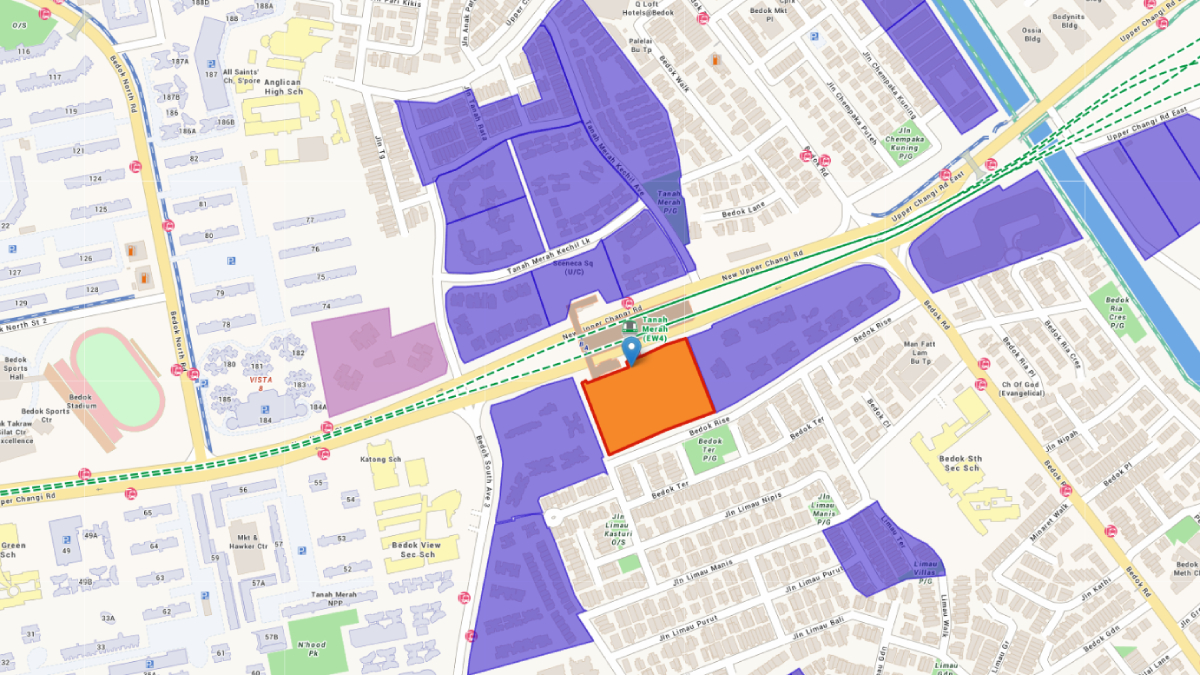
Source: URA
Bedok Rise, located just beside Tanah Merah MRT Station, is largely a private residential estate surrounded by condominiums and landed homes. It provides strong connectivity, being an interchange on the East-West Line and towards Changi Airport.
There is a shortage of new homes in Bedok, the last major launch was in January 2023, when Sceneca Residence made its debut. It has since sold 98.1% of its 268 units. Demand for homes in Bedok has been high, with the latest site at Bayshore Road setting a new record price psf for an OCR site when awarded for $1,420 psf ppr in March 2025.
The new mall at Sceneca Residence located across the street provides amenities while there are several schools in its vicinity, including Temasek Primary School, Bedok View Secondary School, Bedok South Secondary School and the Singapore University of Technology and Design (SUTD). There are also several commercial and industrial nodes such as Changi Business Park, Changi Airport and the future Changi East Urban District close by. Therefore, developers’ keen interest is expected for this site.
Woodlands Drive 17 (EC) – 560 units
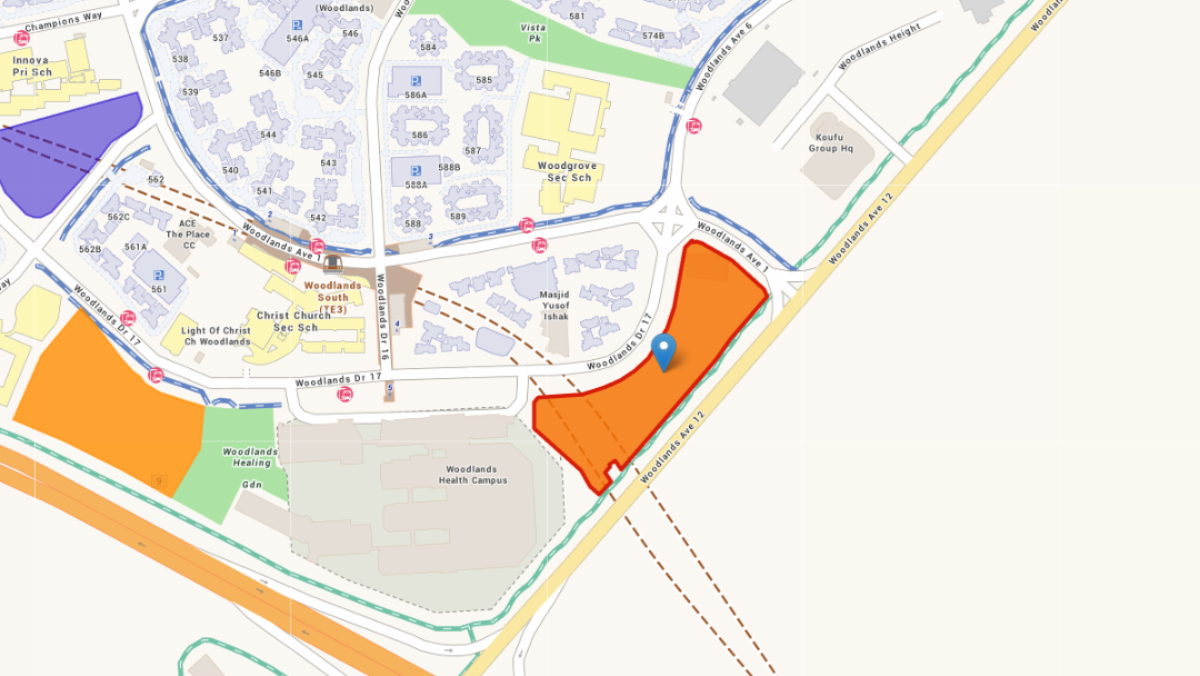
Source: URA
Among the two EC sites announced in this round’s GLS programme, this Woodlands Drive 17 site stands out as the premier option for upgraders in the North region. The location and name of this site might ring a bell, as a nearby EC site along the same road was launched for tender in 1H 2025.
Traditionally, ECs are located in less-prime areas relative to private developments, making them a more budget-friendly option in exchange for further distances from key amenities. However, this site will be located a walk away from Woodlands South MRT station, which enhances its connectivity to other locations on the Thomson-East Coast Line. Residents can also enjoy dining options at Woodlands Health Campus just next door.
The popularity of this site will largely depend on the bids received for the closing of the earlier Woodlands Drive EC, which would take place in August. Developers could wait for the results of the bidding process to plan or adjust their bidding strategy respectively. Additionally, this is the 4th EC site launched in the North region in the same year, which could further pace the demand. However, despite all this, we should definitely see a fairly competitive bidding process for this site, as EC sites generally offer lower risk for developers.
Dairy Farm Walk – 500 units
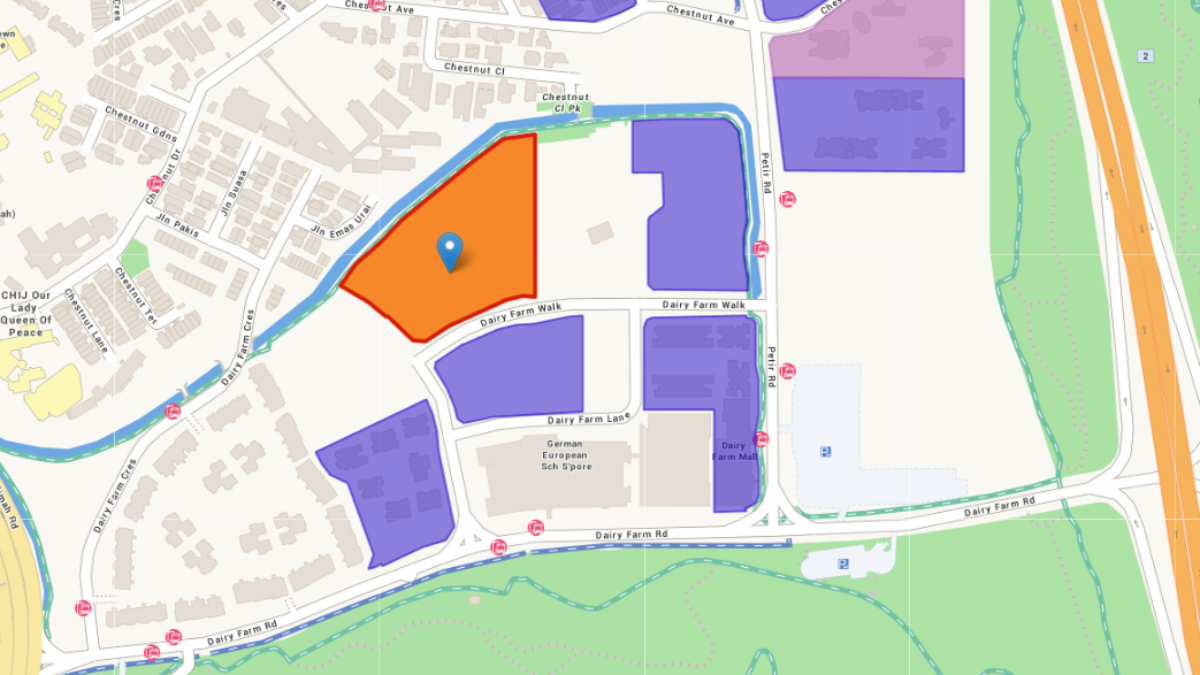
Source: URA
Located near Hillview MRT station, Dairy Farm has been transformed to become a new housing cluster. Amenities there include HillV2 and Dairy Farm Mall, with the Rail Mall being slightly further away.
Presently, there are eight private developments surrounding the MRT station. The last site, also along Dairy Farm Walk, was awarded in January 2025 for $1,020 psf ppr. It had drawn two bidders and when completed, it can yield up to 540 units. This would mean competition for buyers, with more than 1,000 units available.
It is unlikely for developers to be competing strongly for this site.
Dunearn Road – 370 units
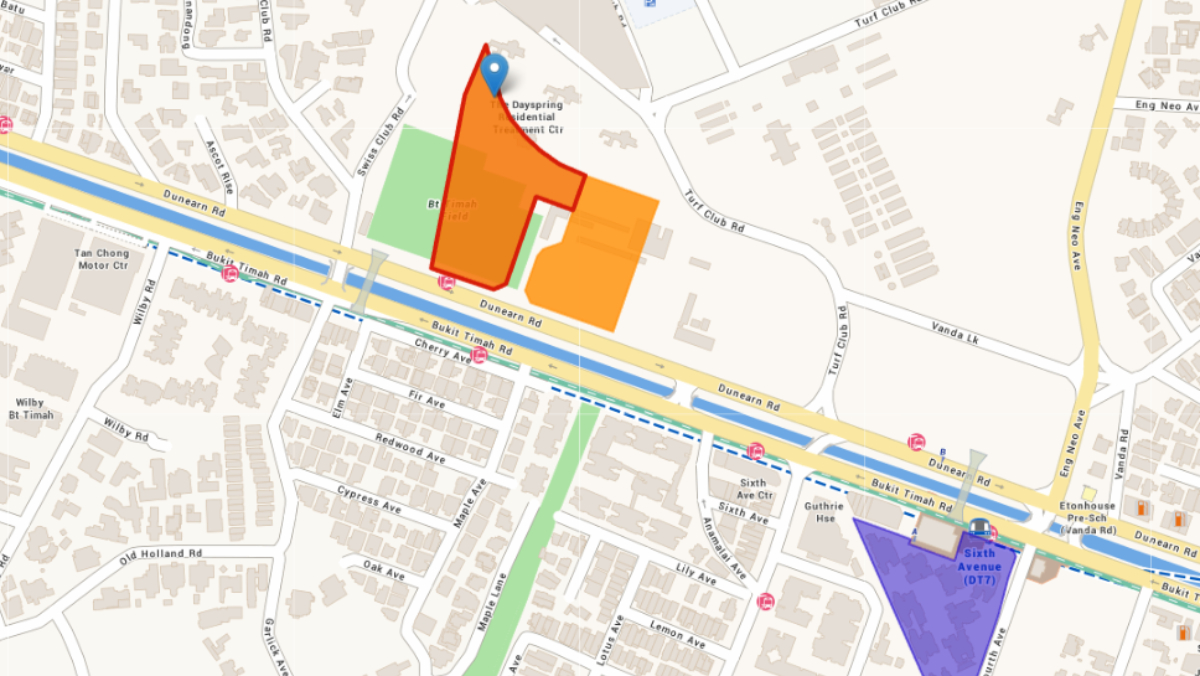
Source: URA
The Dunearn Road is the second site to be announced in the vicinity, following the debut of a previous site in the 1H 2025 Confirmed List. The tender for the earlier site will close in late-June this year, and developers could take cue from the results in their bids for this plot.
Demand for this site will be fuelled mainly by the Turf City transformation. This could encourage older residents from nearby landed estates to consider this as a right-sizing opportunity. The site is also close to Sixth Avenue MRT station.
Dover Road – 625 units
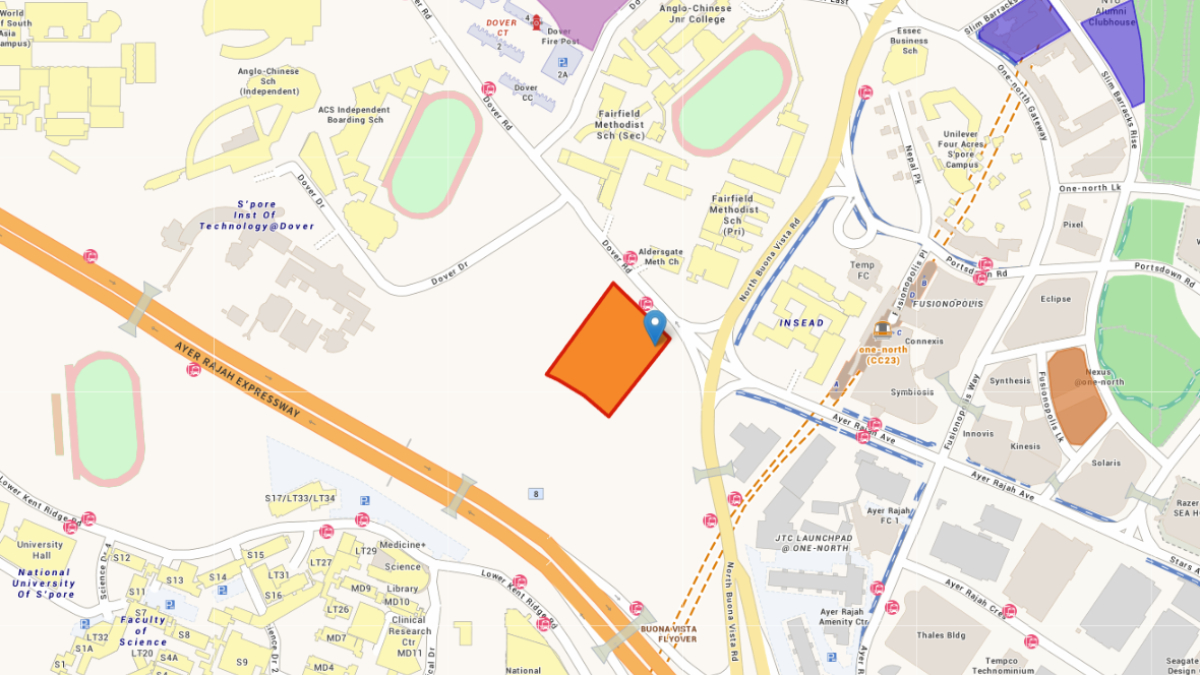
Source: URA
Among the sites unveiled in the 2H 2025 GLS slate, Dover Road stands out with the highest estimated residential yield of approximately 625 units, along with a commercial component of 3,000 sqm. The site is also situated closely to the one-north innovation district, much like recent GLS sites, such as Media Circle (Parcels A and B).
However, Dover Road is more likely to appeal to aspiring owner-occupiers and working families as its location offers better access to one-north MRT station and a cluster of well-regarded schools. These include Anglo Chinese Junior College and Fairfield Methodist School (Primar and Secondary).
The site also carries historical value as it sits on the former Dover HDB estate which consisted of Blocks 30-39. This marks the maiden residential development on the plot since its demolition in 2018 – 2019.
Tanjong Rhu Road – 525 units
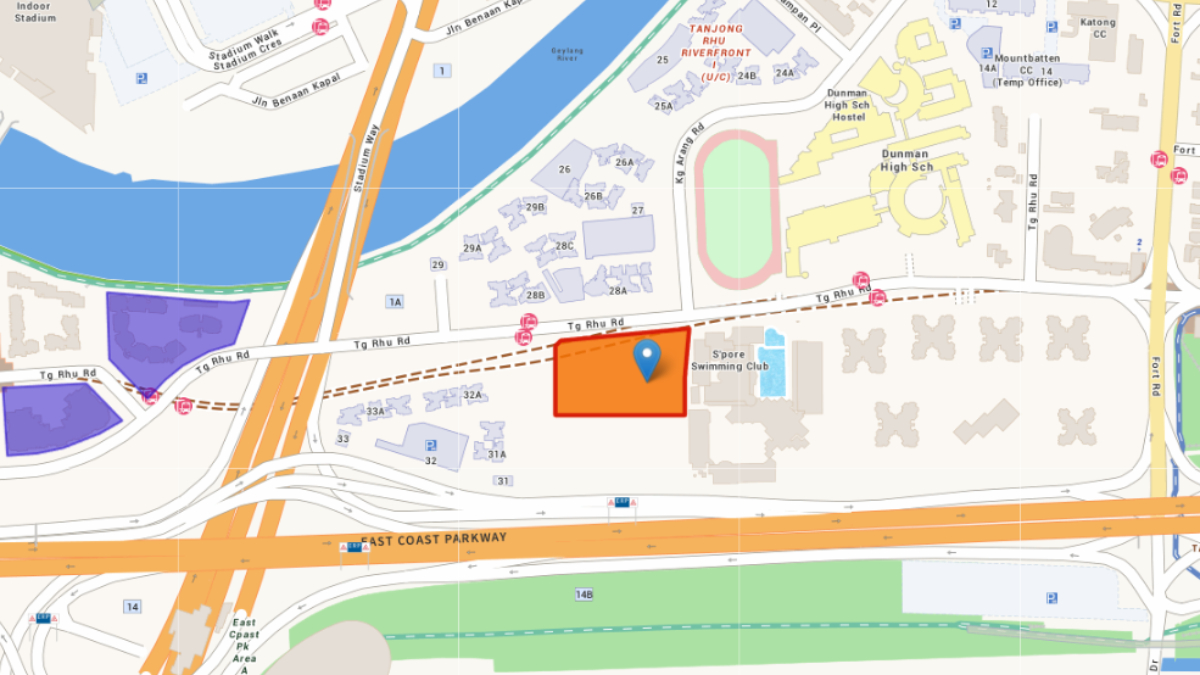
Source: URA
This is the first residential GLS plot to be released along Tanjong Rhu Road in nearly three decades since 1997, making it a rare opportunity for developers seeking to cater to sustained upgrader demand in the city-fringe locale.
Its attractiveness is further enhanced by its proximity to key infrastructure and amenities. These include Tanjong Rhu MRT station on the Thomson-East Coast Line, offering seamless access to the CBD, and the nearby Singapore Sports Hub, which is part of the Kallang Alive master plan that is transforming the precinct into a major sports and lifestyle destination.
Kallang Avenue – 450 units
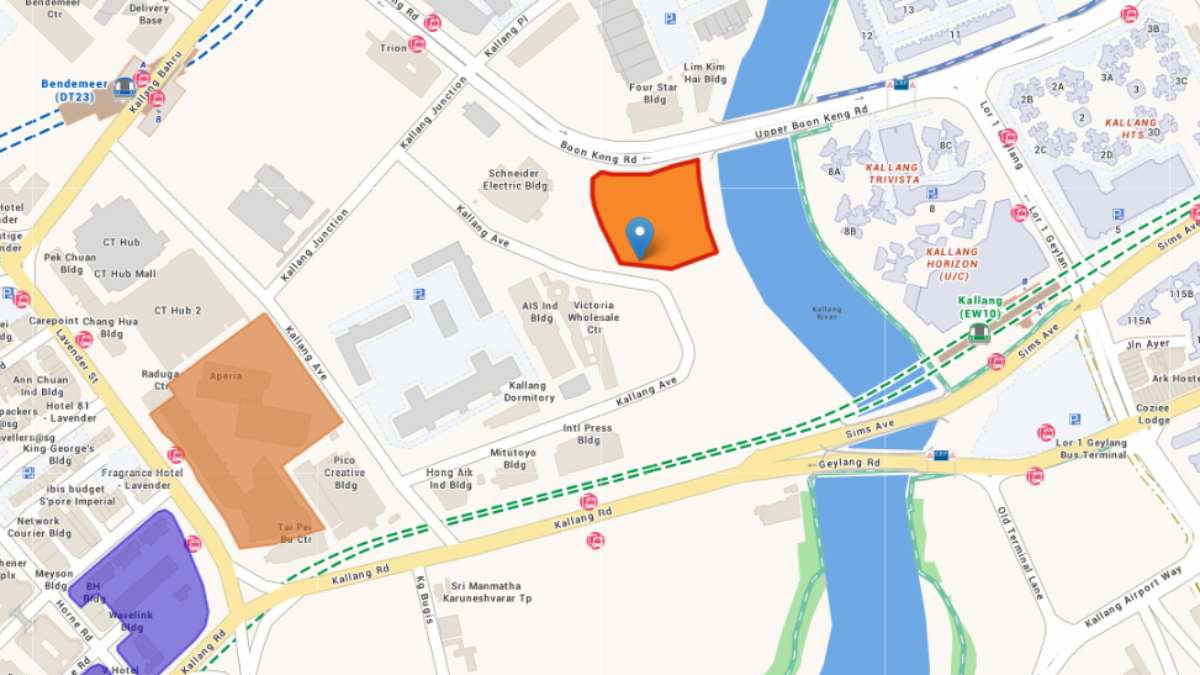
Source: URA
The Kallang Avenue site is within a 10-minute walk to both Kallang and Bendemeer MRT Stations. Some units will have unblocked waterfront views, overlooking Kallang River. There will also be a small commercial section within the development, that will provide amenities for residents.
Located between Kallang Avenue and Boon Keng Road, this site would be a potential site for HDB upgraders. The newer HDB estates have yielded several million-dollar flat in the past few years.
Despite being located within an industrial estate, developers are likely to be keen on this site.
Lentor Central – 580 units
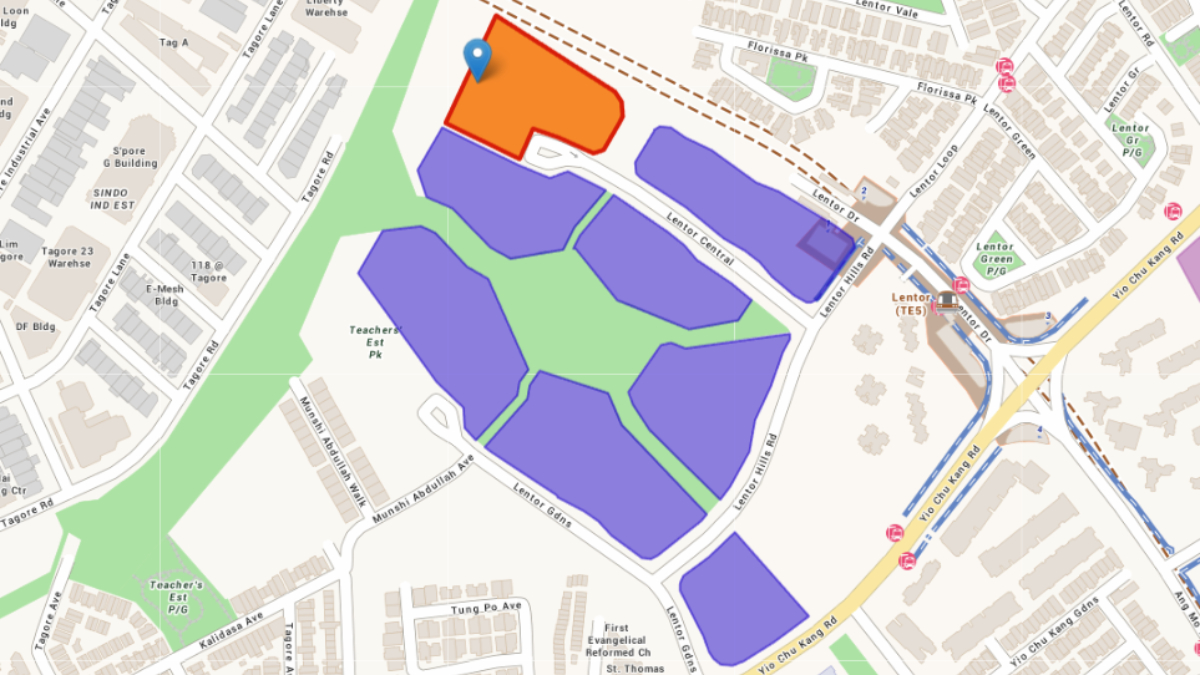
Source: URA
Lentor, being located within the established and centrally located Ang Mo Kio town, has ample amenities and strong connectivity. All seven sites that were previously launched have been sold. Hence, the Lentor Hills estate saw a fresh injection of seven GLS sites initially. Despite yielding close to 3,500 units in total, there was still steady demand across all the projects.
Most recently, Lentor Central Residences sold 93% of its 477 units at its launch. Till date, excluding the latest Lentor Gardens site that was awarded in April 2025, there are less than 100 units remaining.
We can expect developers to closely watch this site, as it has promised a strong demand from both HDB upgraders in nearby towns, and right-sizers from the surrounding landed estates, due to its convenient location and nearby MRT within walking distance.
Miltonia Close (EC) – 430 units
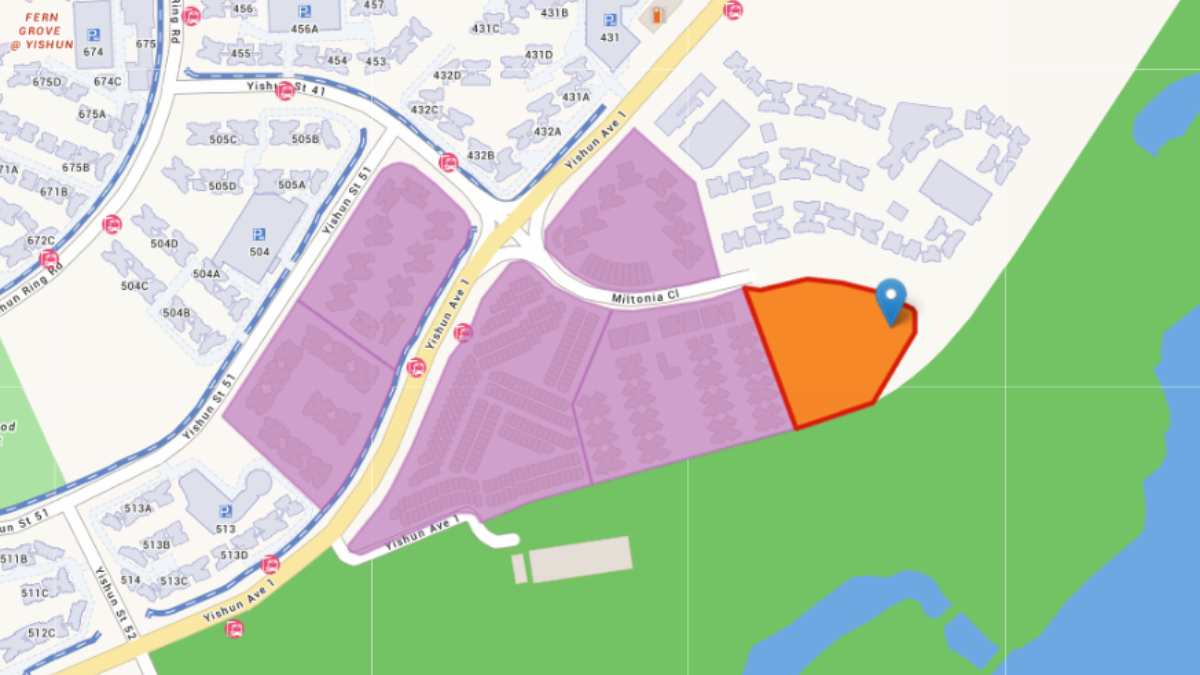
Source: URA
The second EC GLS site of this half, the Miltonia Close EC site will be located off Yishun Ave 1, adjacent to Lower Seletar Reservoir Park.
The location attributes of this site are less desirable compared to the other EC site at Woodlands Drive 17. The biggest difference would be transport connectivity, where residents of this future site would have to spend 15-20 minutes on a bus commute to the nearest MRT of Khatib – whereas the Woodlands Drive site is closer to the MRT station.
However, this site promises a few unique attributes, such as a greenery and waterfront view overlooking the reservoir and park connector, as well as its location away from the main road surrounded by other private developments.
There should be a strong demand for ECs in Yishun, as the most recent EC in the town, North Gaia sold out all of its units earlier in the year. With the HDB focusing development in Yishun, particularly the upcoming Chencharu precinct with shorter waiting time projects, this could introduce future demand for the project.
Disclaimer
This information is provided solely on a goodwill basis and does not relieve parties of their responsibility to verify the information from the relevant sources and/or seek appropriate advice from relevant professionals such as valuers, financial advisers, bankers and lawyers. For avoidance of doubt, ERA Realty Network and its salesperson accepts no responsibility for the accuracy, reliability and/or completeness of the information provided. Copyright in this publication is owned by ERA and this publication may not be reproduced or transmitted in any form or by any means, in whole or in part, without prior written approval.
This is part one of an article series examining the Additional Buyer Stamp Duty (ABSD) on foreigners.
It has been slightly more than two years since April 2023 when the Additional Buyers Stamp Duty (ABSD) was increased across the board. While Singaporeans and Singapore Permanent Residents (SPR) experienced an increase of between 3% and 5% on their second and third property purchases, foreigners faced a much steeper 30% rise, elevating their ABSD rate on any property purchase to 60%.
Hence, with foreigners bearing the brunt of this ABSD adjustment, it calls into question whether the high ABSD rates in the current market environment should be reviewed in the long run.
Introduced in 2011, the ABSD was designed as a cooling measure to curb property speculation and ensure housing affordability amidst strong overseas buying interest in Singapore’s relatively small market. Since then, the ABSD has undergone a series of rate revisions, but its core objective has remained the same: to curb speculation and keep price inflation in check.
Table 1: Timeline of ABSD adjustments
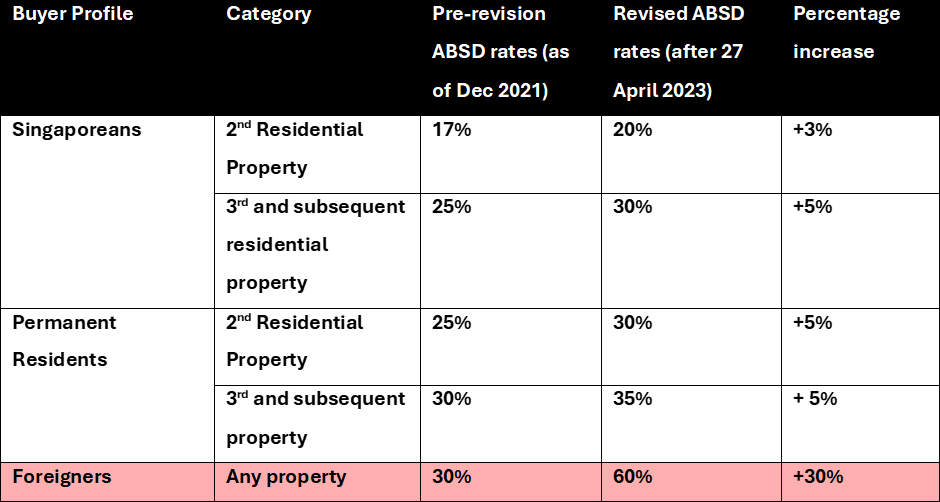
Source: Monetary Authority Singapore
How has the ABSD adjustment impacted demand in the residential market?
Singaporeans have consistently formed the majority of home buyers in the private non-landed residential market (excluding ECs). For instance, between 2Q 2021 and 1Q 2025, local demand from both Singaporeans and Permanent Residents constituted approximately 97% of home buyers island-wide. In contrast, foreigners purchasing Singapore homes accounted for only 3% of transactions over the same period.
Table 2: Share of buyers of non-landed private properties (excl. EC) from 2Q 2021 to 1Q 2025

Source: URA, ERA Research and Market Intelligence
Although foreign demand constitutes a minority, it has traditionally been concentrated in the Core Central Region (CCR) compared to the Rest of Central Region and Outside Central Region (OCR). This is driven by the CCR’s proximity to business hubs and the availability of luxury developments. In 1Q 2023, shortly before the ABSD hike was introduced, the proportion of foreign buyers ranged between 2.5% and 15% across various market segments. Subsequently, the share of foreign buyers declined across all market segments, with the Core Central Region (CCR) being the most affected. The foreign share in the CCR dropped from 15.8% in Q1 2023 to 8.4% in Q2 2023.
Chart 1: Foreign Demand in the Residential Market
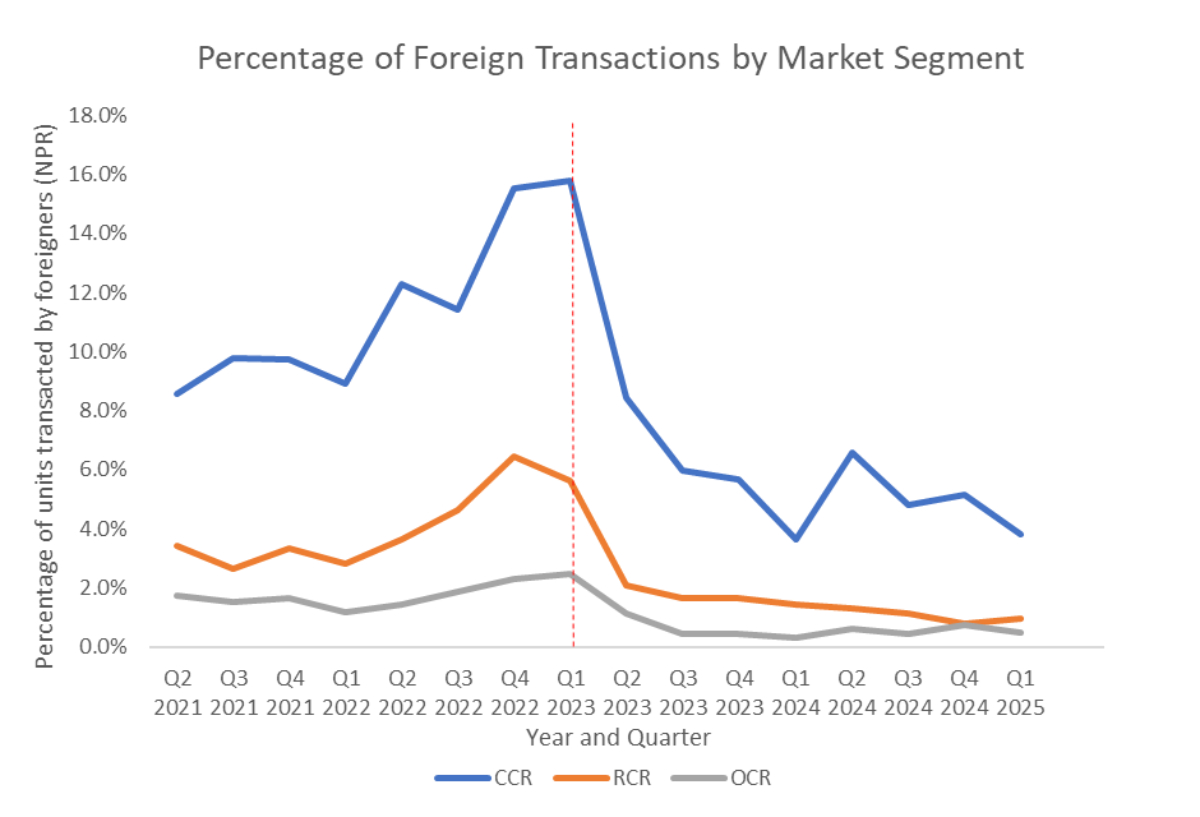
Source: URA REALIS, ERA Research and Market Intelligence
Is foreign demand the leading cause of rising property prices?
Consequently, a vital question to consider is whether foreign demand significantly contributes to housing price appreciation. Firstly, we have observed that local demand represented the majority of demand across the CCR, OCR, and RCR, with foreigners making the smallest share of transactions.
While the April 2023 ABSD adjustment effectively curbs foreign demand, it may have a limited effect on reducing price increases in the overall housing market.
Chart 2: Property Price Index of non-landed private residential properties in CCR, RCR and OCR
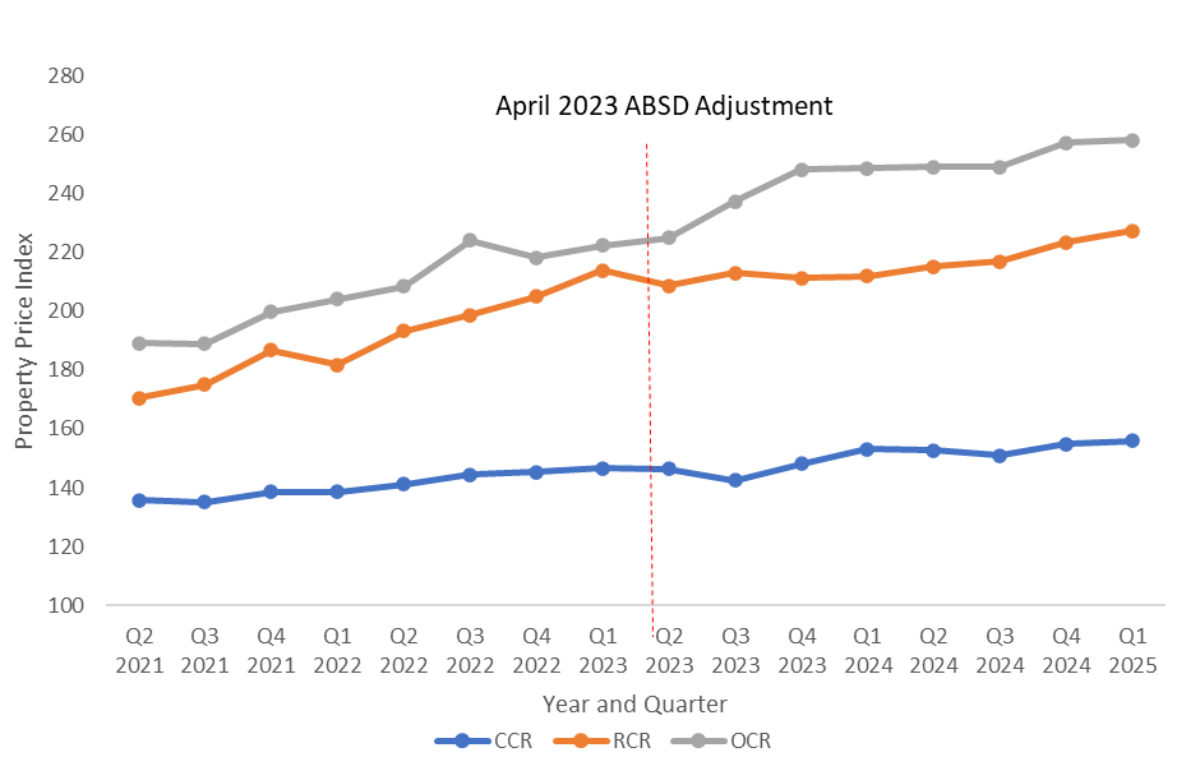
Source: URA, ERA Research and Market Intelligence
Examining the property price index, property price performance for the CCR seems sluggish after April 2023, with a compound annual growth rate (CAGR) of 3.2%, the lowest among the three market segments. Two factors contribute to this. On the demand side, it is evident that the effect of the post-April ABSD adjustment has suppressed foreign demand.
Supply-side factors have also contributed to the slow growth of CCR property prices. As shown in Table 4, there is an overall decrease in new units launched following the ABSD adjustment, which limits the available stock in the CCR and slows down the momentum of price growth. This could also indicate that developers may be more cautious due to the high ABSD rates imposed on foreigners, who represent a significant buyer profile in the CCR.
Table 3: Number of new units launched in the CCR across 1Q 2021 to 4Q 2024

Source: URA, ERA Research and Market Intelligence
Meanwhile, the RCR and OCR segments have continued to show comparatively more substantial price growth post-ABSD adjustment, sustained by local demand. The continued increase in property prices for RCR and OCR thus demonstrates that local demand remains resilient despite the increased ABSD rates.
Conclusion: Should ABSD rates for foreigners be reviewed?
Local demand has been the primary driver of residential property price growth in Singapore. Despite the sharp increase in ABSD rates, overall prices have continued to rise, further demonstrating foreign buyers’ limited impact on prices.
As Singapore continues to position itself as a global business hub, this raises the question of whether it is time to reassess the ABSD rates on property purchases by foreigners in order to preserve the country’s long-term attractiveness. This reassessment should ideally take into account the diverse profiles and intentions of foreign buyers.
In other words, a more nuanced policy approach could be considered – one that distinguishes between speculative investment and genuine housing needs.
On that note, in our next article, we will analyse how the doubling of foreign ABSD rates has affected skilled foreign talent in Singapore and what it signifies for Singapore’s future concerning broader policy trade-offs.
Disclaimer
This information is provided solely on a goodwill basis and does not relieve parties of their responsibility to verify the information from the relevant sources and/or seek appropriate advice from relevant professionals such as valuers, financial advisers, bankers and lawyers. For avoidance of doubt, ERA Realty Network and its salesperson accepts no responsibility for the accuracy, reliability and/or completeness of the information provided. Copyright in this publication is owned by ERA and this publication may not be reproduced or transmitted in any form or by any means, in whole or in part, without prior written approval.
ERA, Where Service Begins with Seeing People
In every aspect, it was a small deal. Yet the impact? Transformative.
For Ming Hao, being a trusted adviser involves more than just pursuing clients with million-dollar listings; it means being present for those whom others might overlook.
He initially encountered her, a middle-aged woman struggling with unemployment and health problems, when she was looking for assistance in renting out a room in her house. She was uncertain about how to price or stage the room and felt too shy to approach potential tenants because of language barriers.
Most agents would have walked away, but Ming Hao stepped in.
The house was in poor condition. The spare bed was unusable, and the wardrobe was damaged. Therefore, Ming Hao quietly repaired what he could. Observing her difficulty in assembling the new furniture she had ordered online, he approached her, put it together himself, and dedicated hours to assist her without expecting anything in return.
In his role as her agent, he provided guidance on fair pricing. When she decided to exclude standard items such as a table and chair, he respected her decision without judgment.
Because she struggled to communicate with tenants, Ming Hao personally escorted each individual who viewed the property—translating, advocating, and patiently guiding them through the process. It required almost two months and numerous viewings before the room was eventually rented.
“It hardly felt like work,” Ming Hao reflected. “I simply wanted to help her enjoy life a bit more comfortably.”
The rental provided her with essential income—modest but impactful. While others might view it as a low-value deal, Ming Hao recognised an opportunity to serve passionately.
“Was it difficult? Yes. Am I anticipating a big reward? No,” he shared after being recognised as ERA’s #2 in Best Customer Service among thousands of agents. “I simply wanted to assist sincere and humble individuals to improve their lives—even if it’s just by adding a side to their cai png.”
His story went viral within ERA circles, even earning praise from CEO Marcus Chu during the recent Asia Pacific Business Conference 2025.
“Picture yourself arranging room rentals, receiving a barrage of compliments from the CEO for two full minutes in front of all those high achievers,” he quipped. “My restless night before was justified, and I’m sure countless sleepless nights to come will be worth it.”
Although Ming Hao might not currently possess the connections for luxury deals or the endurance to knock on doors for 12 hours daily, he is steadily developing his career based on a more profound quality: sincerity.
What I can do now is to assist every one of my clients carefully, patiently, and tenderly, regardless of their profile or quantum.
The outcomes are evident. On ERA’s Property Portal, he consistently garners a 5.0-star rating, with reviews highlighting his professionalism, empathy, and meticulous attention to detail:
“Truly impressed by his professionalism and efficiency… found a tenant who matched my criteria within three days.”
“Earnest and attentive in understanding my situation.”
“Conscientious, clear communication, non-pushy, and he delivers.”
Ming Hao’s dedication is a reflection of a broader culture of excellence, contributing to ERA Singapore’s impressive 99.8% professional excellence rating from clients.
For Ming Hao, service transcends numbers; it embodies presence, patience, and the ability to make people feel recognised. In a fast-paced world focused on speed and scale, his narrative serves as a reminder that often, the most profound impacts arise from the simplest acts of kindness.

ERA, Where Real Estate Meets Real Care
Certain homes encompass more than just furniture; they embody entire lifetimes.
When door-knocking, Jasmine Chan encountered a couple in their late 70s and early 80s. The pair had been living in the same landed home for over 50 years. With no children to support them and the husband recovering from a stroke, they had quietly adjusted to lead more frugal, simpler lives—handwashing their clothes daily and sleeping in the living room because they could no longer manage the stairs.
Most agents would have seen a sale; Jasmine saw a responsibility.
She gently recommended rightsizing to a more accessible HDB flat near the wife’s elderly mother. But the couple had no cash savings to fund the move. So Jasmine negotiated a 6-month rent-free extension with the buyers, giving them time to sell their property first and then use the proceeds for their next home.
She didn’t stop there. She bought them a washing machine, labelled all its buttons, and personally taught them how to use it. When they struggled to buy groceries, she attempted to teach them how to order online. However, when the task proved too difficult, she intervened and personally placed their grocery orders for two full months.
Even now, they continue to reach out to her whenever they need assistance with anything.
“It was never just about buying or selling,” Jasmine shared. “It was about ensuring they could live safely, comfortably, and with dignity.”
Throughout their property journey, Jasmine was there. She guided them in applying for the Proximity Housing Grant, coordinated timelines, provided budgeting advice, and ensured the move could happen without any stress.
For Jasmine, this represented more than just a transaction. It embodied a profoundly human transition, approached with clarity, kindness, and patience.
Jasmine’s real estate strategy is reflected in her perfect 5.0-star rating on ERA’s Property Portal, with clients characterising her as:
“A top-notch agent who consistently delivers exceptional results.”
“Instrumental in helping me achieve my investment goals.”
“Proactive, dedicated, and someone I trust implicitly with my properties.”

She’s one of the many ERA agents contributing to the brand’s 99.8% professional excellence rating, as rated by clients across Singapore.
ERA, Where Expertise Shapes Trust
In Singapore’s highly competitive real estate market, few sectors are as intricate and as unforgiving as landed properties. The rules are different, the risks are higher, and the clients are some of the most discerning.
One real estate agent who knows this landscape inside out is Alexs Chua, a seasoned real estate professional whose name has become synonymous with landed expertise.
With over three decades of experience, multiple industry recognitions, and a leadership role in shaping professional standards for agents, Alexs represents a different breed of realtor: not just a salesperson, but a true adviser.

On the ground and in his element, Alexs conducting a landed property tour, breaking down site-specific insights for clients and co-broke agents alike.
When Small Assumptions Almost Sink Big Deals
In landed sales, even a small misunderstanding can derail a million-dollar transaction.
Alexs recalls a case early in his career where a deal nearly collapsed, not because of price, but because of unclear legal terms.
The Option to Purchase (OTP) included a clause stating that if the relevant department didn’t reply within 14 days, the status would be deemed satisfactory.
The buyer’s lawyer hesitated.
“What if a negative reply comes after the 14 days?” they worried.
Both sides stalled. It was Alexs, through careful research and a simple real-time check on the government portal, who clarified the situation and moved the deal forward.
The lesson?
“In landed transactions, the real problems aren’t usually obvious. It’s the overlooked details, the fine print, the outdated assumptions, that can hurt you most,” he shares.
Why Landed Properties Can Become a Legal Minefield
Unlike HDBs or condominiums, landed homes come with layers of technicalities that aren’t visible at first glance.
From boundary issues to drainage reserves, from setback rules to zoning restrictions, overlooking even one detail can trigger expensive consequences.
One of the most common mistakes Alexs has seen? Misrepresenting Built-In, Built-Up, and Gross Floor Areas (GFA).
“Many agents assume these terms are interchangeable, but they’re not,” Alexs explains. “Built-in refers to usable interior space. Built-up can include external walls or sheltered areas. GFA is used for planning control. Misunderstanding these can lead to unrealistic buyer expectations—and worse, legal liability.”
Another frequent misstep is assuming all landed homes can be rebuilt, extended, or redeveloped freely—without verifying if the property falls under conservation guidelines or specific URA planning controls.
“When agents rely purely on the seller’s claims without independent checks, they leave themselves—and their clients—vulnerable,” he emphasizes.
How Real Expertise Is Built—Not Bought
Alexs’s reputation as a landed property specialist wasn’t built overnight, it was forged from frustration, self-learning, and relentless pursuit of the truth.
Fresh out of National Service in 1992, he tried to assist his aunt in buying a landed home. The advice he received from different co-broking agents was confusing and contradictory. Rather than giving up, he dug deeper—calling URA, consulting architects, and studying regulations.
That early determination to understand the complexities of landed transactions laid the foundation for his future. Alexs handled countless real-world legal cases, sharpening his instincts even further. He became known not just for closing deals, but for safeguarding clients from unseen risks.
His contributions extended to the national level: Alexs served on the committee that helped develop the Council for Estate Agents’ (CEA) Professional Service Manual (PSM), setting industry standards that real estate salespersons in Singapore still follow today.
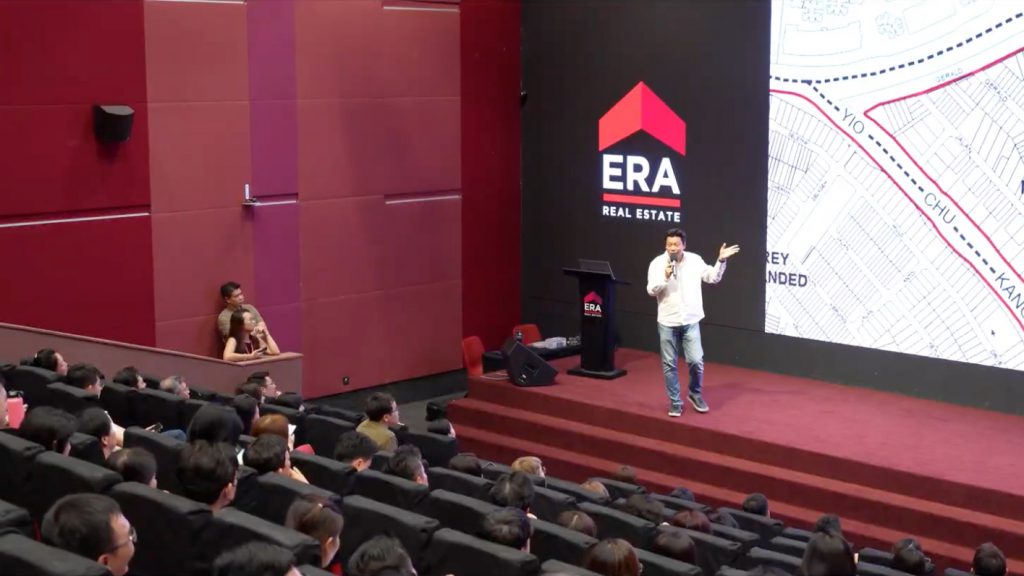
From fieldwork to front of room, Alexs sharing decades of landed expertise with fellow agents during a training session at ERA APAC Centre.
Why Landed Expertise Matters More Than Ever
Today’s landed buyers aren’t just wealthy—they’re highly informed. They hire architects, builders, and consultants. They demand transparency and precision.
In this environment, surface-level knowledge isn’t enough.
“With the stakes so high, a single mistake—whether it’s misquoting buildable area or ignoring zoning rules—could cost a buyer millions,” Alexs explains. “True landed expertise is about seeing what others miss, asking the right questions, and delivering advice that protects—not just promotes.”
In a market where trust is everything, agents who master these complexities stand out far above the rest.
The Right Mindset for Aspiring Landed Agents
For agents who have dabbled in landed deals but still feel uncertain, Alexs offers grounded advice:
“You don’t have to know everything overnight. But you must be committed to learning, doing due diligence, and always acting legally, morally, and ethically,” he shares.
He emphasizes that experience in landed property comes not just from success, but from humility—acknowledging what you don’t know, and having the discipline to check before you speak.
“You don’t need to be a legal expert. But you need to know where the traps are—and who to ask when you’re unsure.”
The ERA Advantage: A Platform for Growth
Today, at ERA, Alexs continues his mission of raising industry standards, sharing his deep knowledge, and helping agents avoid costly missteps. He sees ERA’s strong collaborative culture, wealth of training resources, and Asia Pacific network as the perfect platform for nurturing the next generation of trusted property advisers.
“Real estate isn’t just about selling homes—it’s about protecting people’s investments and dreams. That’s what a true landed agent does.”
ERA, Where Strategy Meets Opportunity
For many, real estate is about buying and selling homes. But for Chloe Zhang, it’s about something deeper—bridging cultures, guiding clients through unfamiliar terrain, and helping people from all walks of life, including Chinese nationals and Singapore-based families, find their place in a city they’re proud to call home.
Having relocated to Singapore herself, Chloe understands the uncertainties of starting over—learning a new culture, navigating regulations, and figuring out where to begin. Today, she uses that experience to empower a diverse clientele. Whether she’s working with local families, long-time residents, or new investors from abroad, Chloe has become a trusted guide—and a community builder.
Her journey at ERA isn’t just about personal success. Over the years, she’s built one of the largest divisions for Chinese-speaking agents at ERA, mentoring others who, like her, once took a leap into the unknown.
Understanding the Chinese Market
With a strong clientele from China, Chloe has mastered the differences between working with investors and homebuyers. Investors focus on capital appreciation, rental yield, and strategic entry-exit plans—often eyeing MRT proximity, tenant demand, and future urban developments. Homebuyers, meanwhile, look for family-friendly environments, reputable schools, and even favourable Feng Shui.
“Each group has unique concerns,” Chloe explains. “The key is understanding their motivations and customising the approach to meet their needs.”
Breaking Down Barriers for Foreign Buyers
For many Chinese clients, purchasing property in Singapore comes with uncertainty. Regulations like Additional Buyer’s Stamp Duty (ABSD), financing rules, and eligibility concerns can be overwhelming. Chloe addresses this with clarity and structure—offering guidance on loans, taxes, and market outlook, while partnering with reliable bankers and lawyers to ensure every transaction goes smoothly.
“A clear, data-driven strategy gives them the confidence they need,” she shares. “It’s not just about selling; it’s about giving them peace of mind.”
Walking the Talk
Chloe doesn’t just advise clients—she invests too. Last year, she sold her newly TOP unit and bought a new launch at Emerald of Katong, drawn by its location, design, and developer reputation.
“I believed in the project’s potential for both appreciation and rental yield,” she says. “And going through the process myself helped me give even better advice to my clients.”
Building a Division, Shaping Careers
Chloe’s success led her to team building, where she saw potential in mentoring fellow Chinese agents who had transitioned from corporate roles. “Many were motivated but unsure how to navigate this new space,” she says.
She developed a structured onboarding system with market training, negotiation coaching, and cultural guidance. Weekly training sessions, site visits, and role-playing exercises ensure her team is always learning.
“At the heart of it, we focus on credibility, empathy, and professionalism,” she shares. “That’s how trust is built.”
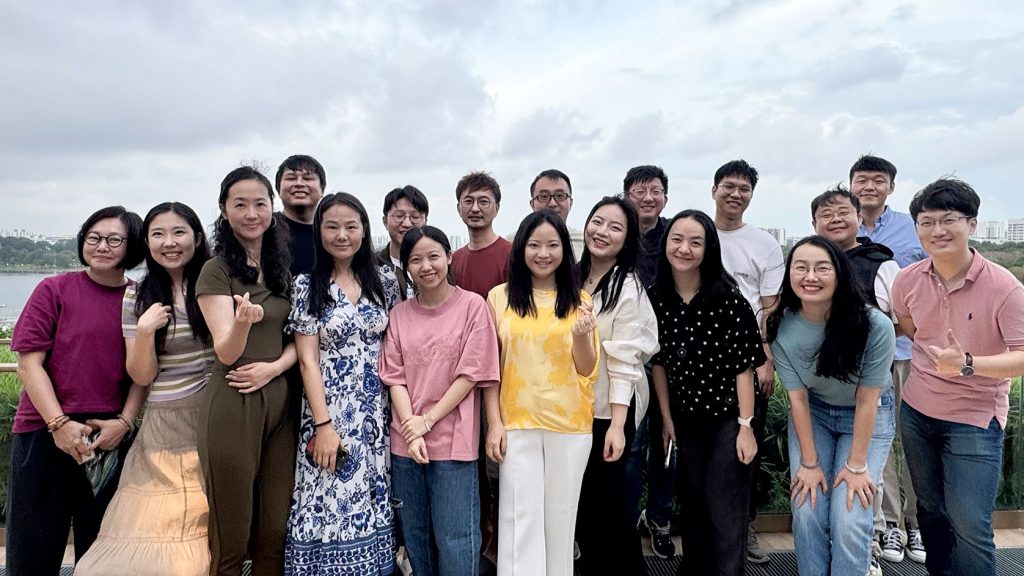
More than just a team—Chloe leads one of ERA’s largest divisions for Chinese-speaking agents, united by trust, growth, and shared success.
Powered by ERA’s Global Platform
ERA’s Asia Pacific network has played a key role in Chloe’s growth. Cross-border collaborations allow her to serve clients expanding into multiple markets. ERA’s data tools and marketing platforms help her agents stay informed and agile.
“Having ERA’s support system—from tech to training—gives us a major edge in today’s competitive landscape,” she explains.

Milestones made possible through support and strategy — Chloe celebrates her Millionaire Achiever status with ERA’s leadership team.
A Vision for the Future
Looking ahead, Chloe aims to grow her division and groom the next wave of trusted advisors. Her focus is on quality, not just numbers. “I want to build a team known for knowledge, integrity, and results,” she says.
She’s also ramping up recruitment to bring in passionate, driven individuals who share her vision. “With the right support, anyone can succeed,” she adds.
Final Advice
For agents hoping to tap into the Chinese market, Chloe’s advice is simple: go beyond the sale. “Understand your client. Respect their culture. Keep learning. And always act in their best interest,” she says.
In her words, real estate isn’t just a transaction—it’s a connection. And at ERA, Chloe Zhang is helping agents and clients alike cross borders, build bridges, and unlock new possibilities.
ERA, Where Strategy Meets Opportunity
When Melina Yap’s clients first came to her, they had one goal—sell their home at Esparina Residences and upgrade. But by the time they were done, they hadn’t just sold their home at a record price—they had also secured a rental at One Holland Village and purchased two brand-new units at Parktown Residences.
It wasn’t luck. It was strategy. And it was only possible with the right planning, insights, and ERA’s powerful tech tools helping them every step of the way.
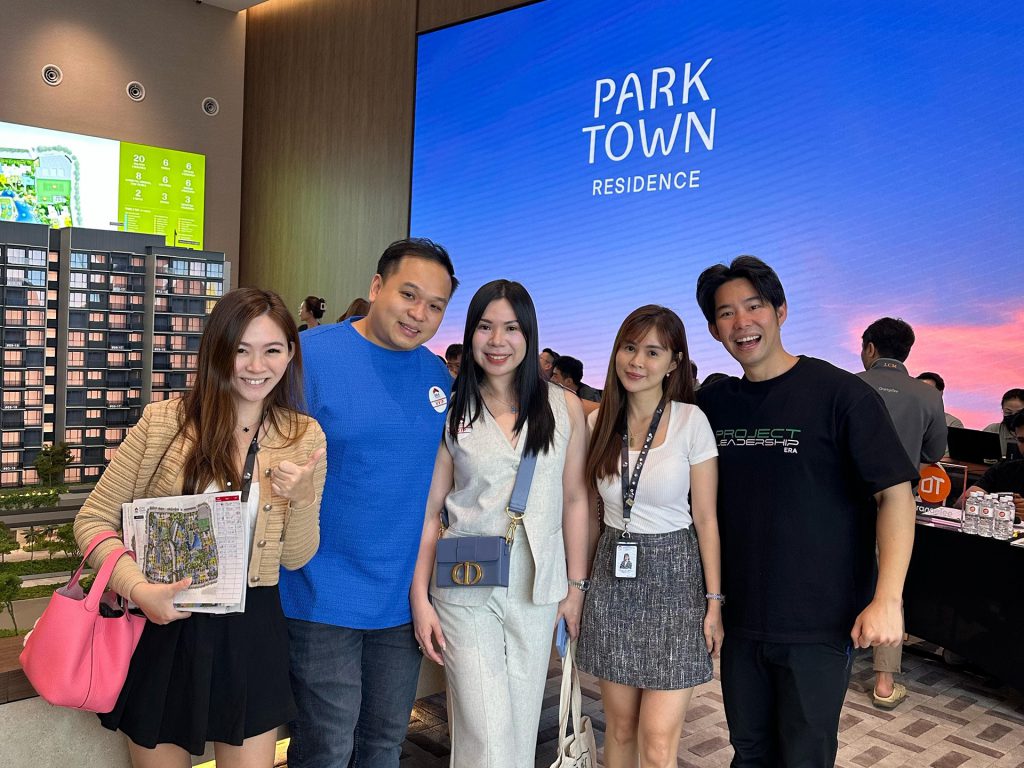
A moment of success captured—celebrating another seamless multi-step move with happy clients.
With a track record of consistently achieving Superstar and Diamond Achiever awards at ERA, Melina is no stranger to navigating complex transactions. “Many wouldn’t know the sweat, stress, and effort behind every closing and award,” she shares. “Real estate isn’t just about selling—it’s about building trust, long-term planning, and making the right moves at the right time.”
Step One: Selling & Securing a Temporary Home
The couple was eager to move to a bigger home in the city-fringe but needed a clear financial plan to do so. Melina helped them sell their Esparina Residences unit at a record price, ensuring they maximized their cash proceeds before making their next move.
Since their next purchase wasn’t confirmed yet, they needed a temporary home. Rather than simply assisting with a rental search, Melina advised them on a smarter approach—looking for listings on their own to save on agent fees, while she personally vetted their tenancy agreement to ensure they got the best deal.
They eventually settled on One Holland Village, a brand-new development in a vibrant location with easy access to amenities—ticking all their boxes for a comfortable transition.
Step Two: From One Home to Two
With their finances planned out and a rental secured, the couple explored their next big move—purchasing their dream home. Initially, they were unsure whether to go for a private resale unit or a new launch, but Melina guided them through the advantages of new launches.
Using ERA’s SALES+, she mapped out a financial and timeline strategy with tools like Project Whiz and financial calculators, giving them a clear picture of their options. They soon realized that progressive payments and stamp duty flexibility made new launches a more strategic choice for them.
What started as a plan to buy one unit turned into two. After carefully reviewing their finances, they saw the potential to invest in a second unit—allowing them to plan for both their future home and long-term property gains.
Step Three: Reshuffling the Strategy for Priority Access
Initially, they were considering two different developments, wanting to diversify their investment. However, their queue numbers weren’t ideal, meaning their selection would be limited—or worse, they might not even get a unit at all.
Seeing this, Melina re-strategized on the spot, recommending they consolidate their purchases in Parktown Residences.
With developer’s Multiple Purchase Scheme, they gained priority access, securing two prime units in the development—each fitting different aspects of their future plans.
“It was the perfect balance between lifestyle and long-term growth,” Melina shares. “Especially with Parktown Residences being an integrated development, it offered unmatched convenience, which was a key factor in their decision-making.”
 Consistent recognition—Melina’s strategic thinking and client commitment shine through in every transaction she handles.
Consistent recognition—Melina’s strategic thinking and client commitment shine through in every transaction she handles.
Beyond Transactions—A Long-Term Property Plan
Melina’s expertise didn’t just help her clients sell, rent, and buy seamlessly—it gave them a long-term real estate strategy that worked in their favor.
By leveraging ERA’s real-time analytics from ERApro and transaction planning tools in SALES+, she ensured her clients made the most of every opportunity at every step of the journey.
“The key to a successful upgrade isn’t just about selling and buying—it’s about timing, planning, and strategy,” she explains. “Every decision is interconnected, and having the right data, tools, and market insights makes all the difference.”
A Realtor Clients Keep Coming Back To
For Melina, real estate isn’t just about a single deal—it’s about building trust and long-term relationships.
“A lot of my clients start by engaging me for one sale, but they stay because they see the value of long-term property planning,” she shares. “When they realize that real estate moves aren’t just transactions but stepping stones to greater opportunities, they come back—and they refer their friends and family.”
With a client-first approach, expert knowledge, and ERA’s cutting-edge technology, Melina ensures every move isn’t just a decision—it’s a well-calculated strategy for the future.

A proud moment—Melina leaves her mark at ERA’s Millionaire Gala, celebrating a year of strategic wins and satisfied clients.
In an ever-changing market, having the right agent makes all the difference.